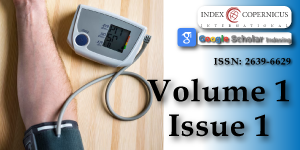Sex Differences in Hypertension: A Question worth Asking?
Main Article Content
Article Details
Copyright (c) 2017 Lombardi M, et al.

This work is licensed under a Creative Commons Attribution 4.0 International License.
Yoon SS, Gu Q, Nwankwo T, Wright JD, Hong Y, Burt V. Trends in blood pressure among adults with hypertension: United States, 2003 to 2012. Hypertension. 2015; 65: 54-61. Ref.: https://goo.gl/yliJHD
Mozaffarian D, Benjamin EJ, Go AS, Arnett DK, Blaha MJ, et al. American Heart Association Statistics Committee; Stroke Statistics Subcommittee. Heart Disease and Stroke Statistics-2016 Update: A Report from the American Heart Association. Circulation. 2016; 133: e38-360. Ref.: https://goo.gl/1jcO9T
James PA, Oparil S, Carter BL, Cushman WC, Dennison-Himmelfarb C, et al. 2014 evidence-based guideline for the management of high blood pressure in adults: report from the panel members appointed to the Eighth Joint National Committee (JNC 8). JAMA. 2014; 311: 507-520. Ref.: https://goo.gl/7jo7U4
Caldarone E, Lombardi M, Severi P, Leggio M. Ambient Air Pollution and Hypertension: A Relationship that Strikes Around the Clock. Arch Clin Hypertens. 2016; 1: 044-045.
Mancia G, Fagard R, Narkiewicz K, Redon J, Zanchetti A, et al. 2013 ESH/ESC guidelines for the management of arterial hypertension: the Task Force for the Management of Arterial Hypertension of the European Society of Hypertension (ESH) and of the European Society of Cardiology (ESC). Eur Heart J. 2013; 34: 2159-2219. Ref.: https://goo.gl/NmBOr1
Williamson JD, Supiano MA, Applegate WB, Berlowitz DR, Campbell RC, et al. SPRINT Research Group. Intensive vs Standard Blood Pressure Control and Cardiovascular Disease Outcomes in Adults Aged ≥75 Years: A Randomized Clinical Trial. JAMA. 2016; 315: 2673-2682. Ref.: https://goo.gl/7PHO9I
Wenger NK, Ferdinand KC, Bairey Merz CN, Walsh MN, Gulati M, et al. American College of Cardiology Cardiovascular Disease in Women Committee. Women, Hypertension, and the Systolic Blood Pressure Intervention Trial. Am J Med. 2016; 129: 1030-1036. Ref.: https://goo.gl/5fMClN
Boggia J, Thijs L, Hansen TW, Li Y, Kikuya M, et al. International Database on Ambulatory blood pressure in relation to Cardiovascular Outcomes Investigators. Ambulatory blood pressure monitoring in 9357 subjects from 11 populations highlights missed opportunities for cardiovascular prevention in women. Hypertension. 2011; 57: 397-405. Ref.: https://goo.gl/926nkw
Hermida RC, Ayala DE, Mojón A, Fontao MJ, Chayán L, et al. Differences between men and women in ambulatory blood pressure thresholds for diagnosis of hypertension based on cardiovascular outcomes. Chronobiol Int. 2013; 30: 221-232. Ref.: https://goo.gl/5JFIDa
Nomura K, Asayama K, Thijs L, Niiranen TJ, Lujambio I, et al. International Database of Home Blood Pressure in Relation to Cardiovascular Outcome Investigators. Thresholds for conventional and home blood pressure by sex and age in 5018 participants from 5 populations. Hypertension. 2014; 64: 695-701. Ref.: https://goo.gl/TjwqEp
Ji H, Zheng W, Li X, Liu J, Wu X, et al. Sex-specific T-cell regulation of angiotensin II-dependent hypertension. Hypertension. 2014; 64: 573-582. Ref.: https://goo.gl/XzrGa5
Pollow DP, Uhrlaub J, Romero-Aleshire MJ, Sandberg K, Nikolich Zugich J, et al. Sex differences in T-lymphocyte tissue infiltration and development of angiotensin II hypertension. Hypertension. 2014; 64: 384-390. Ref.: https://goo.gl/Sj4moH
Sandberg K, Ji H, Hay M. Sex-specific immune modulation of primary hypertension. Cell Immunol. 2015; 294: 95-101. Ref.: https://goo.gl/IW8FMp
Meng X, Yang J, Dong M, Zhang K, Tu E, et al. Regulatory T cells in cardiovascular diseases. Nat Rev Cardiol. 2016; 13: 167-179. https://goo.gl/qrqWA1
Crislip GR, Sullivan JC. T-cell involvement in sex differences in blood pressure control. Clin Sci (Lond). 2016; 130: 773-783. Ref.: https://goo.gl/u7UPO5
Tipton AJ, Sullivan JC. Sex differences in T cells in hypertension. Clin Ther. 2014; 36: 1882-1900. Ref.: https://goo.gl/OpdLYQ
Chappell MC, Marshall AC, Alzayadneh EM, Shaltout HA, Diz DI. Update on the Angiotensin converting enzyme 2-Angiotensin (1-7)-MAS receptor axis: fetal programing, sex differences, and intracellular pathways. Front Endocrinol (Lausanne). 2014; 4: 201. Ref.: https://goo.gl/np1brf
Pessôa BS, Slump DE, Ibrahimi K, Grefhorst A, van Veghel R, et al. Angiotensin II type 2 receptor- and acetylcholine-mediated relaxation: essential contribution of female sex hormones and chromosomes. Hypertension. 2015; 66: 396-402. Ref.: https://goo.gl/ECG734
Hilliard LM, Nematbakhsh M, Kett MM, Teichman E, Sampson AK, et al. Gender differences in pressure-natriuresis and renal autoregulation: role of the Angiotensin type 2 receptor. Hypertension. 2011; 57: 275-282. Ref.: https://goo.gl/pb0NwM
Zhang JD, Patel MB, Song YS, Griffiths R, Burchette J, et al. A novel role for type 1 angiotensin receptors on T lymphocytes to limit target organ damage in hypertension. Circ Res. 2012; 110: 1604-1617. Ref.: https://goo.gl/5JKA2M

